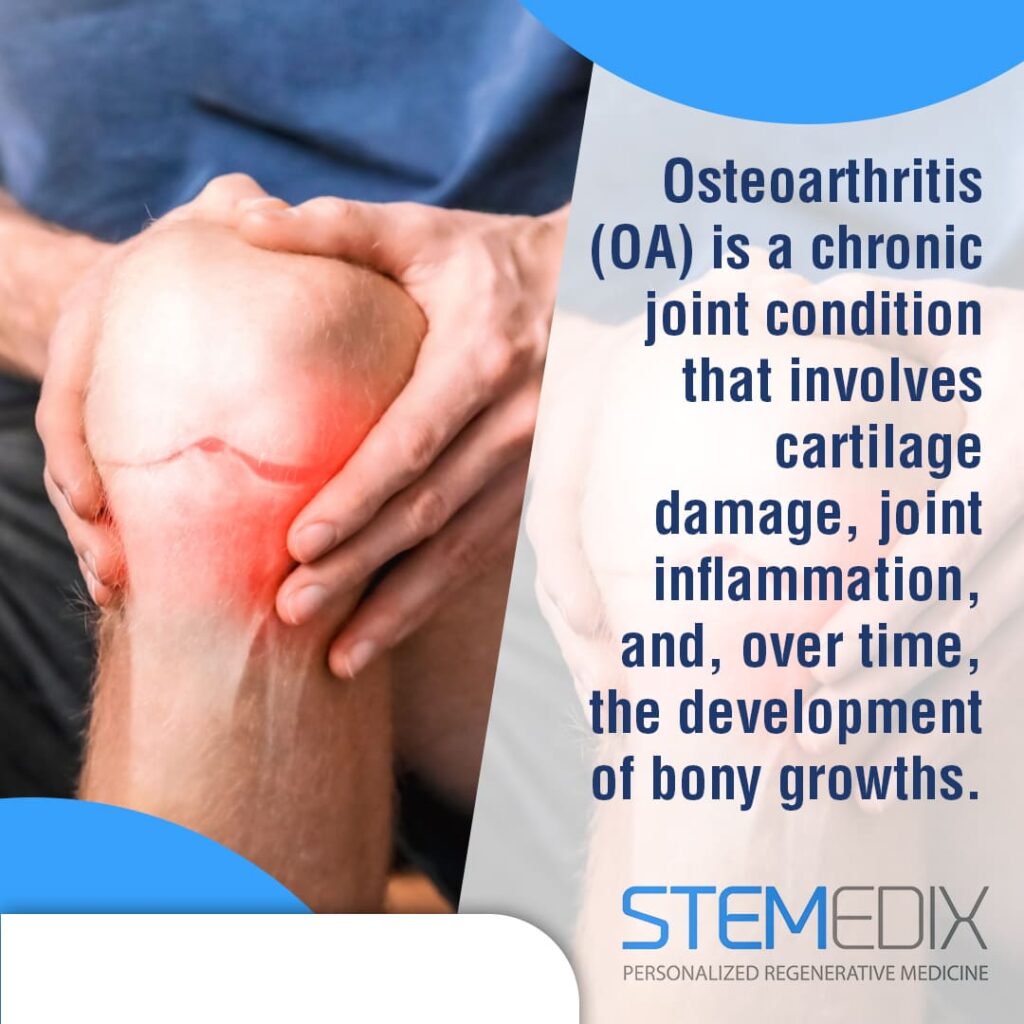Osteoarthritis and aging both impact your joints, but they are distinctly different processes. While natural aging causes gradual changes in joint structure, osteoarthritis is a diagnosed condition that results in progressive cartilage damage and joint pain. Recognizing the signs and symptoms of osteoarthritis, especially early osteoarthritis symptoms, is important for managing your joint health effectively.
At Stemedix, we focus on providing personalized stem cell therapy for osteoarthritis designed to support your body’s natural healing processes. This therapy is designed to support your body’s natural response to joint inflammation and help maintain joint function, helping you stay active and maintain your quality of life. Recognizing how aging and osteoarthritis differ allows you to make correct decisions about your treatment options. This article explains these differences and how stem cell therapy may play a role in your joint care journey.
Aging Joints vs. Osteoarthritis: What’s the Biological Difference?
You might notice your joints feel a bit stiffer or less flexible as you get older, but these changes don’t always mean you have a disease. Analyzing how normal aging differs from osteoarthritis can help you better manage your joint health.
Age-Related Joint Changes: Natural Degeneration Without Disease
Aging leads to gradual joint changes, even in healthy individuals. Over time, the cartilage that cushions your bones gradually loses water and becomes thinner. This reduces its ability to absorb shocks when you move. Additionally, the fluid that lubricates your joints may decrease, and your ligaments can become less flexible. These changes can lead to mild stiffness or discomfort, especially after periods of inactivity or overuse.
Despite these changes, natural aging does not usually cause inflammation or severe damage inside the joint. Most people with age-related joint changes continue their regular activities with only minor adjustments to how they move or exercise.
Osteoarthritis as a Diagnosed Condition
Osteoarthritis is a joint disease diagnosed by a healthcare professional, involving more than just natural wear and tear. In OA, the cartilage covering the bone ends breaks down at a faster rate, leading to direct bone-on-bone contact. This can cause inflammation, swelling, and damage to the tissues surrounding the joint.
Unlike simple aging, osteoarthritis leads to noticeable structural changes. You may find bone spurs forming and the joint lining thickening, which can reduce movement and increase pain. OA can develop in younger people, too, especially after injuries or if there is a family history of the condition.
Doctors use imaging tests, like X-rays or MRIs, along with physical exams and your medical history, to confirm osteoarthritis by identifying cartilage loss and narrowing of the joint space.
At Stemedix, we work with patients who have been diagnosed with osteoarthritis to explore treatment options that focus on supporting joint health and function. Understanding these differences helps you take the right steps toward managing your joint condition.

Signs and Symptoms of Osteoarthritis: What Goes Beyond Aging
You might notice similar patterns in how your joints feel as you get older, but osteoarthritis develops differently. The signs of this condition reflect disease, not just age.
Early Osteoarthritis Symptoms Often Overlooked
Early signs and symptoms of osteoarthritis often appear mild, so many people mistake them for normal aging. However, these early indicators are different in terms of both cause and progression. In healthy joints, occasional stiffness usually improves with light movement. With early osteoarthritis symptoms, there’s more happening beneath the surface.
You may feel a low level of inflammation around a joint, even though you haven’t had an injury. Mornings can start with stiffness that doesn’t ease after a few minutes. Some describe a subtle warmth or mild swelling around the joint, which may come and go. You might also hear or feel a soft grinding sound—known as crepitus—when moving the joint.
These early symptoms may not seem consistent or intense, which is why they’re easy to overlook. However, unlike age-related changes, early osteoarthritis symptoms often progress over time. The joint tissue continues to break down quietly, which makes it harder to manage later if ignored.
Later-Stage OA and Loss of Function
As osteoarthritis advances, the damage within the joint becomes more noticeable and harder to work around. Cartilage continues to erode, reducing your ability to move freely and without discomfort. At this stage, you may start walking differently without even realizing it. Some people adjust their posture or shift weight to avoid pain, which can affect the whole body.
The pain may no longer improve with rest. Even sitting still, the joint can throb or feel stiff. Everyday activities—like climbing stairs, driving, or exercising—may become more difficult.
Beyond discomfort, late-stage osteoarthritis can restrict how you live. It may affect work or limit how active you can be with friends and family. These limitations often stem from changes that are visible on imaging: narrowed joint spaces, worn cartilage, and bony growths.
At Stemedix, we support individuals who have already been diagnosed with osteoarthritis. If your symptoms are progressing or if early signs have been confirmed through evaluation, regenerative therapy options may be worth exploring with your care team.
Stem Cell Therapy for Osteoarthritis: How It Supports Joint Health
If you’ve been diagnosed with osteoarthritis, you may already be exploring ways to support your joints without adding more medications or surgeries to your treatment path. Stem cell therapy uses your body’s own resources to target joint changes at the cellular level.
The Role of Mesenchymal Stem Cells (MSCs)
Mesenchymal stem cells (MSCs) play a supportive role in joints affected by osteoarthritis. These adult stem cells are typically collected from your own fat tissue or bone marrow. In stem cell therapy for osteoarthritis, they are introduced into the area of joint damage, not to rebuild cartilage directly, but to interact with surrounding tissue in a meaningful way.
MSCs are known for their ability to send out helpful signals. Once in the joint, they influence nearby cells by releasing molecules that help reduce inflammation and support tissue maintenance. This type of signaling helps create a more balanced environment in joints where inflammation and cartilage breakdown are active. It’s not about forcing the body to regenerate but instead giving it tools to support itself.
Many patients come to us after their joints have become less responsive to conventional therapies. MSCs are being studied for how they influence pain levels, stiffness, and daily function over time. This therapy is part of an investigational field, and we guide each patient based on individual clinical history and medical documentation.
The Role of Chondrocytes in OA Treatment
Chondrocytes are the only cells found in healthy cartilage, and they’re responsible for producing and maintaining that cartilage. These cells don’t just sit in the joint; they actively respond to wear, damage, and changes in joint stress. Their presence is what keeps cartilage flexible and functional.
Research into regenerative medicine has started to examine how chondrocytes might be used in conjunction with stem cell strategies. Although this is still developing, scientists are looking at how these cartilage-producing cells may play a role in long-term joint support, especially in cases where cartilage breakdown is advanced. At this stage, these studies are helping the field better understand the cellular makeup of joint tissue and how it may respond to future therapies.
At Stemedix, we continue to follow the developments in the research closely to help our patients stay informed about the evolving landscape of regenerative care.
Evaluating Candidacy: What Patients Should Know at Stemedix
Before moving forward with stem cell therapy for osteoarthritis, it’s important to confirm that the condition has already been diagnosed. We focus on building treatments for those who already have clear documentation of their diagnosis.
The Importance of a Confirmed Diagnosis Before Treatment
At Stemedix, we work with individuals who have already received a confirmed diagnosis of osteoarthritis. Before starting therapy, we ask that you provide your existing medical records, including documentation such as imaging reports, physician notes, or clinical evaluations.
This information helps us design a treatment plan that’s based on what your care team has already identified. By reviewing accurate, up-to-date findings from your healthcare providers, we can approach your case with clarity and focus. Our role is to support your goals through regenerative therapy, not to replace the care already being provided by your doctor or specialist. We build on the foundation you already have in place, using that as a guide for what may come next.
How Treatment Plans Are Developed at Stemedix
Once you provide your records, our team reviews them carefully to determine if you are a fit for therapy. We look at your history, your imaging, and the specifics of your diagnosis. If we find that stem cell therapy for osteoarthritis may be appropriate for your situation, we will then create a plan tailored to your joint condition.
This is not a template approach. Every person’s joint health is different, and your treatment reflects that. It’s also important to know that our role is specific: we are not here to take over your full care. We support one part of your health journey while your main doctors continue to guide the rest.
What Makes Regenerative Medicine a Consideration for Osteoarthritis
Some individuals diagnosed with osteoarthritis are now exploring regenerative medicine as part of their symptom management plan. This approach is considered by those seeking alternatives that don’t involve major surgery or daily medication adjustments.
Investigational Status and Responsible Expectations
Stem cell therapy for osteoarthritis is currently categorized as an investigational procedure, and results can vary from one person to another. Some patients report improvements in joint mobility or reduced daily discomfort, but no outcome can be promised.
Stem cell therapy uses cells—often mesenchymal stem cells—that interact with the joint environment. These cells have been studied for their ability to release signals that may influence inflammation and tissue behavior. Current research focuses on how these signals might affect joint structures, such as cartilage and synovial tissue, in the context of chronic joint conditions like osteoarthritis.
You should approach this treatment with clarity and the understanding that it supports ongoing research. Your goals should be based on your current joint function, lifestyle, and medical history, not assumptions about universal outcomes.
Supporting Quality of Life Through Non-Invasive Approaches
Many individuals turn to stem cell therapy for osteoarthritis because it doesn’t involve major surgery or require significant downtime. This makes it a choice for those who are trying to maintain their daily routines or delay more invasive options.
If you’ve already tried physical therapy, exercise plans, or other forms of symptom management, you may be looking for additional support. This therapy may offer a path forward without disrupting what’s already working for you. Some patients use it alongside their existing care, not in place of it.
At Stemedix, we offer stem cell therapy to individuals who have already received a diagnosis of osteoarthritis. We work directly with each patient’s existing records and imaging to customize a treatment plan built around their condition and activity goals.

Staying Active While Managing OA
You don’t have to give up movement because of osteoarthritis. Small changes to your daily habits can help reduce strain on your joints and help you keep doing the things you enjoy.
Strategies Beyond Therapy: Daily Joint Care
Taking care of your joints everyday matters. Many people benefit from steady, low-impact movement such as walking, swimming, or cycling. These activities support strength and circulation without putting extra pressure on sensitive areas.
Your choice of footwear also plays a key role. Shoes with proper support help distribute your body weight evenly, which may reduce stress on your knees, hips, and ankles. If you’re walking for long periods or walking on uneven surfaces, braces or walking aids can help you stay steady and move more comfortably.
These tools and habits work alongside other treatment approaches. They won’t replace therapies, but they can support your mobility and independence over time.
Monitoring Progress Over Time
After you begin any treatment plan for osteoarthritis, it’s important to stay connected with your primary care provider. Regular check-ins allow your doctor to evaluate how your joints are responding over time and decide whether anything needs to be adjusted.
Tools like X-rays or MRIs can give more details about cartilage condition, joint space, or inflammation. If something changes, your doctor can catch it early and suggest the next steps. Staying involved in your care helps keep your progress on track and focused on your goals.
At Stemedix, we encourage every patient to stay active and work closely with their physician to manage their diagnosed osteoarthritis. Our role is to support you with treatment options that fit your condition, not to replace the care of your primary doctor.
Stemedix: Your Next Step Toward Joint Wellness
Osteoarthritis is more than just joint pain—it’s a condition that changes how your body moves and how you feel day to day. Recognizing the difference between normal aging and a diagnosed disease helps you decide what kind of care is right for you. If you’ve already been diagnosed, stem cell therapy for osteoarthritis may offer additional support for your current care plan. At Stemedix, based in Saint Petersburg, FL, we work with patients who are ready to take the next step with non-surgical options built around their existing records and goals.
To speak with a Stemedix team member about stem cell therapy for osteoarthritis, call (727) 456-8968 or email us at yourjourney@stemedix.com. We’ll review your records and help you explore whether this therapy fits your joint care path.


 St. Petersburg, Florida
St. Petersburg, Florida
